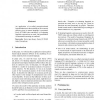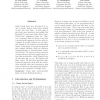EUSFLAT
2007
15 years 2 months ago
2007
The research in the field of the so called Fuzzy Mathematics can be conditionally devided into two mainstreams: the first one emphasizes on the study of different fuzzy structu...
EUSFLAT
2007
15 years 2 months ago
2007
EUSFLAT
2007
15 years 2 months ago
2007
To a fuzzy choice function C we assign the indicators of revealed preference WAFRP(C), SAFRP(C) and the indicators of congruence WFCA(C), SFCA(C). These indicators measure the deg...
EUSFLAT
2007
15 years 2 months ago
2007
In this paper we investigate special types of Lukasiewicz filters. We show their connection to crisp filters. Further, we introduce the notion of Lukasiewicz ideal as a set-func...
EUSFLAT
2007
15 years 2 months ago
2007
We study in this paper the following sequential decision procedure. First, the members of a group show their opinions on all the members, regarding a specific attribute. Taking i...
92
Voted
EUSFLAT
2007
15 years 2 months ago
2007
This paper deals with a model of decision– making in two stages. In the first stage from a set of expertises one chooses the most rational ones, while in the second stage one o...
103
click to vote
EUSFLAT
2007
15 years 2 months ago
2007
Fuzzy formal logics were introduced in order to handle graded truth values instead of only ‘true’ and ‘false’. A wide range of such logics were introduced successfully, li...
EUSFLAT
2007
15 years 2 months ago
2007
Two ways to approximate a proximity relation R (i.e. a reflexive and symmetric fuzzy relation) by a T-transitive one where T is a continuous archimedean t-norm are given. The fi...
104
click to vote
EUSFLAT
2007
15 years 2 months ago
2007
This paper describes a method for formal compression of fuzzy systems. This method compresses a fuzzy system with an arbitrarily large number of rules into a smaller fuzzy system ...
EUSFLAT
2007
15 years 2 months ago
2007
Probability intervals are imprecise probability assignments over elementary events. They constitute a very convenient tool to model uncertain information : two common cases are co...



